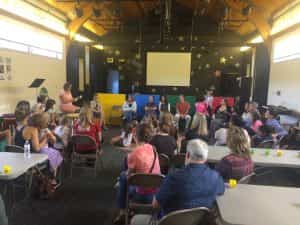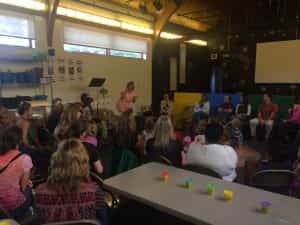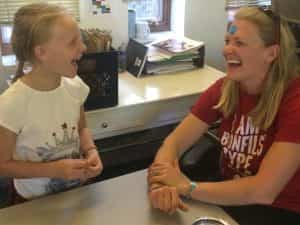 Adults have words for our feelings—we are joyful, angry, disgusted, afraid or sad, and we even have words like pride and envy to describe complex shades of these feelings. Children feel these emotions no less keenly, even if they can’t name them. But it’s these names that help us make sense of our emotions. Naming what we feel in our bodies and brains helps us to understand our emotions and eventually to even own them. The ability to notice anger and say, “I am angry,” is an important step toward being able to pick a strategy to shape and manage this powerful feeling. Social-emotional learning is the process of developing this ability.
Adults have words for our feelings—we are joyful, angry, disgusted, afraid or sad, and we even have words like pride and envy to describe complex shades of these feelings. Children feel these emotions no less keenly, even if they can’t name them. But it’s these names that help us make sense of our emotions. Naming what we feel in our bodies and brains helps us to understand our emotions and eventually to even own them. The ability to notice anger and say, “I am angry,” is an important step toward being able to pick a strategy to shape and manage this powerful feeling. Social-emotional learning is the process of developing this ability.
Neuroscientists are making daily breakthroughs in brain science that are uncovering the complex world of neurodiversity. Psychologists are working hard to utilize the science in the utilization of methods aimed at helping people understand and regulate emotions. A huge challenge in teaching children how to regulate emotions is to discover strategies they connect with, and all the professional research in the world is thrown out the window if they don’t. Mackintosh Academy’s Boulder Campus has been working to implement a social-emotional learning (SEL) curriculum that uses a unique and connecting strategy.
Based on the popular Pixar movie Inside Out, our SEL curriculum and approach helps meet kids where they are, with language they understand, to take three steps to emotional regulation: 1) recognize how they’re feeling; 2) on a scale of 1-10, recognize how “big” is the emotion; 3) know what strategies they can use to keep their emotions in the 1-5 range, which is essential for their readiness to learn. The hope is that every student will ultimately be able to say: “I am feeling… I need to…” when working to process, understand, and regulate their emotions.
Mackintosh started teaching social-emotional learning (SEL) classes based on this framework last school year with strong results. A huge part of the success was owed to the framework being designed, prototyped, tested, and adapted with consistent feedback from teachers and students. In September of this school year we offered an evening parent-child workshop to introduce families to our new strategy. We started by introducing the Inside Out characters: Joy, Disgust, Fear, Anger and Sadness, each with its own color. In the movie, Joy is the protagonist’s main emotion, but the others also work their way in. Then we talked about how these emotions can be “big” or “small.” Then we worked with situations that could create these emotions: If you were hiking through a forest and the trail disappeared, what colors of Play Doh would you use to model your mix of emotions? Finally, we used design materials to build models of things or activities that we use to manage our emotions. During this step parents built models of gardens and yoga classes (this is Boulder after all).
 These Inside Out education workshops helped us remember the importance of involving a critical player in the development of children’s emotional regulation: parents. When Mackintosh and other guest parents preview strategies their children learn to unpack and regulate emotions, adults are becoming powerful mentors and role models. We are hopeful that our SEL curriculum and practices will continue to move and grow beyond our school’s walls to make it into the homes and lives of our community.
These Inside Out education workshops helped us remember the importance of involving a critical player in the development of children’s emotional regulation: parents. When Mackintosh and other guest parents preview strategies their children learn to unpack and regulate emotions, adults are becoming powerful mentors and role models. We are hopeful that our SEL curriculum and practices will continue to move and grow beyond our school’s walls to make it into the homes and lives of our community.
One of the underlying messages in Inside Out is that emotions and life in general can be messy. When it comes to managing emotions there isn’t one answer or solution that works for everyone all the time. Likewise, we believe that there isn’t any “one size fits all” SEL curriculum or approach. For example, we purposefully lean in with CASEL recommended programs like Responsive Classroom because their practices and principles help our campus to create a safe, supportive, and caring learning community. We found, however, that we needed to create our own dynamic tool for teaching emotional intelligence; Pixar’s timing couldn’t have been better.
Another thing that we discovered in our journey was that many of the core elements of SEL are embedded in our International Baccalaureate curriculum. As parents and teachers, we know that learners have individual learning profiles. When a Mack learner progresses through our K-5 (Primary Years Program) and then 6-8th (Middle Years Program) they will have had upwards of 50 different units of study that, regardless of the subject focus, all have learner profiles such as “principled,” “risk-taker,” and “creative” embedded in the exploration and academic study. By exposing learners to IB learner profiles in a spiraling curriculum, we are giving children even more opportunities to understanding their own emotional realities.
By helping students know themselves—the landscapes that create the ecosystems of their emotions—and by teaching students the language and strategies they need transform their emotional experience of the world at school and at home, we hope to demonstrate that emotions have value. A student’s experience is real. It matters. And it is something that a student can choose to shape with intention and care. Students who know and can transform their emotions are ready to learn in their heads and in their hearts, and ultimately to help make the world a better place for others.
~Mack-Boulder’s Educational Psychologist Kristi Pikiewicz, PhD
